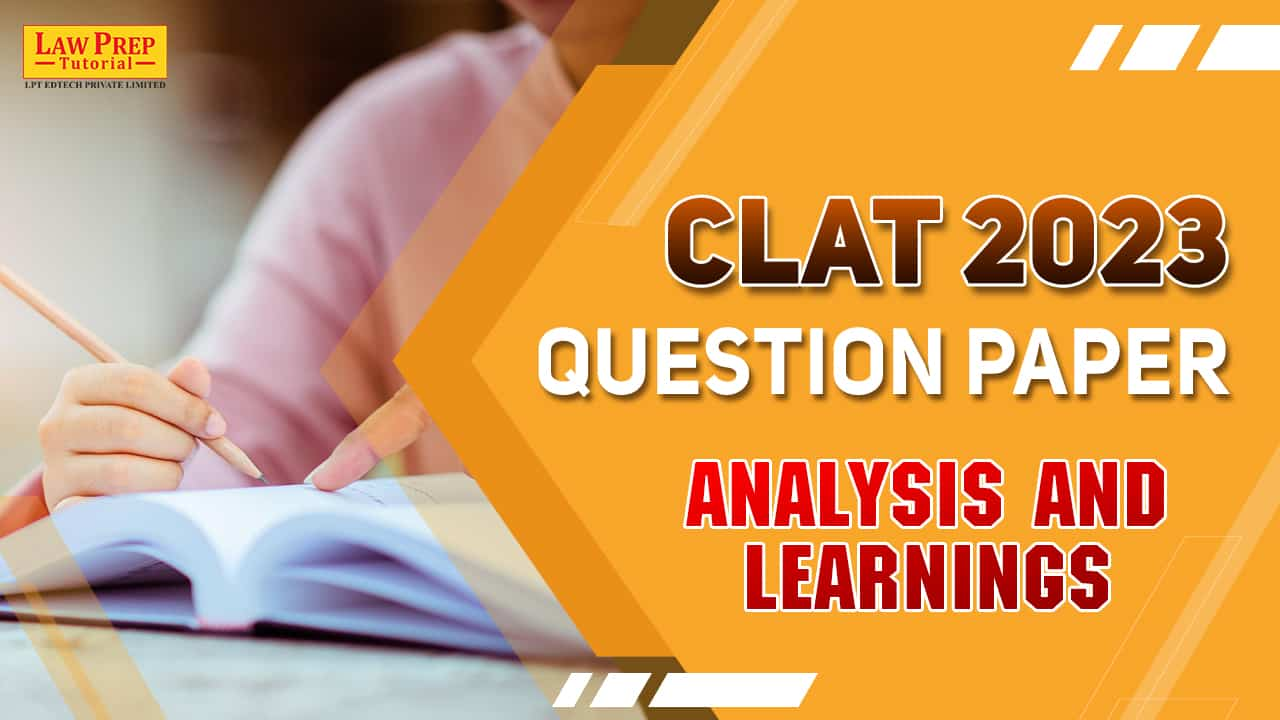Did you appear for CLAT 2023? Are you preparing for CLAT 2024? Either way, analysing the CLAT question paper 2023 is crucial. It not only helps you understand the exam pattern but prepares you for the exam and highlights the key areas you need to work on. For any law aspirant, analysis of previous year CLAT question papers can boost their score by 5-8%, placing them right at the list of top rankers.
The consortium of NLUs conducted the CLAT exam 2023 on Dec 18, 2022, from 2-4 pm. This national-level entrance exam was held in 127 centers across 23 states and 2 union territories in India.
According to candidates who appeared for this exam, most have claimed that the CLAT paper 2023 was lengthy. They agreed that English and legal reasoning were easier, while quantitative aptitude was trickier and time-consuming.
Students might be aware of the exam pattern, topics, and challenges, but in-depth analysis can boost your preparation and prepare you for the unexpected. You get more clarity while studying each subject and learn to manage your time wisely. If you are eager to know about the CLAT 2023 question paper, then you have landed at the right place.
This blog will explain each section of the 2023 CLAT examination question paper, including difficulty level, section-wise weightage, key highlights, and the right approach. Spare a few minutes and give it a thorough read, and we assure you that you will find it immensely helpful.
Upcoming CLAT Exams:
Subject-wise Analysis of CLAT Question Paper 2023
There are 5 sections in the CLAT exam, as mentioned below, each with a different number of questions and topics.
- English
- Current Affairs (General Knowledge)
- Legal Reasoning
- Logical Reasoning
- Quantitative Techniques
Our subject experts at Law Prep Tutorial have analysed each section based on key takeaways, difficulty levels, and types of questions. Aspirants preparing for the CLAT 2024 exam will surely find this section-wise explanation helpful.
1. English
The English section tests candidates’ command over grammar, vocabulary, and language. CLAT examination question paper 2023 had 6 passages with 30 questions in this section. Most of them were simple and contextual, but a few were a bit tricky. Hence, the difficulty level was moderate.
Highlights
- The paper was lengthy compared to the CLAT 2023, with some challenging questions, mainly because the passages were too long.
- The section consisted of different types of passages, such as descriptive, historical, narrative, literary, etc.
- The questions mostly revolved around inferences, but there were a few vocabulary-based questions. Other topics included idioms, grammatical concepts, and phrases.
- The average length of passages was between 250-300 words.
- Questions were straightforward and contextual.
- Many students believe that it was the easiest section of CLAT last year question paper.
Number of Questions
- The Dig – Article: 5 questions (moderate)
- The Provincial Reader – Short story: 5 questions (moderate)
- Dreamers: How Young Indians Are Changing Their World – Novel: 5 questions (easy)
- Water Mafia – Article: 5 questions (easy to moderate)
- Trick Mirror: Reflections on Self-Delusion – Novel: 5 questions (moderate)
- Haroun and the Sea of Stories – Novel: 5 questions (moderate)
Useful Resources for You:
Reading Comprehension for CLAT
2. Current Affairs and GK
This was an unexpected section for most students, with 35 questions from 5 passages. The current affairs section of CLAT 2023 paper had questions on varied topics, with moderate to difficult level.
Highlights
- Topics included FIFA 2022, Growth of the Indian Agricultural Sector, Crypto firm FTX, AI CHATBOT: LaMDA, Draupadi Murmu.
- Some of the questions were out of the box, which were untraditional (unpopular games like Chess)
- Each passage also had some static orientation questions, which ranged from 1-2 questions per passage.
- Around 2-3 questions were asked from the main topic while 5-7 questions were round the periphery of the topic.
- Two key factors that could have helped students crack this section were extensive knowledge of the latest news, events, and happenings around the world and presence of mind.
Useful Resources for You:
3. Legal Reasoning
Legal Reasoning had 8 passages with 40 questions. The questions were based on different laws and judgements, contract law, and related topics.
Candidates who regularly read important articles and newspapers for CLAT found the section easier, while some thought it was moderate, considering that it was a bit lengthy.
Highlights
According to our subject expert analysis of CLAT question papers, the key takeaways are:
- The passages were based on current legal issues rather than on conventional topics of Constitution, torts, criminal law and contract law.
- The students who had developed a habit of reading articles and judgements on diverse legal issues such as Income tax law, IPR laws, Politics etc were in an advantageous position.
- Topics of the given passages were NALSA, Cruelty, Internet Shutdown, Surrogacy, Electoral Bond, Consumer Protection Act, Criminal Procedure Identification Act 2022, and Blocking of Twitter Accounts.
- The sources of passages were The Wire, The Hindu, The Indian Express, Nyaaya India, News Laundry, etc.
Useful Resources for You:
Legal Reasoning Previous Year Paper Analysis
CLAT Legal Reasoning Preparation
4. Logical Reasoning
Logical Reasoning had 30 questions from 5 passages, which were easy and revolved around critical reasoning. However, a few questions were trickier, so students proficient in time management had the upper hand.
Highlights
After a detailed analysis of question paper of CLAT 2023, we can say:
- There were more conceptual questions and fewer contextual ones.
- Students needed not more than 30 minutes to attempt answers and achieve 90% accuracy. So, time management was crucial for this section.
- The difficulty level was moderate, as a few questions were straightforward while others were challenging.
- The length of the passages was between 300-420 words.
- Students needed not more than 45 minutes to attempt answers and achieve 90% accuracy. So, time management was crucial for this section.
- For students with clear concepts, this section was a piece of cake.
- Critical reasoning concepts include strengthening the author’s argument, central idea, the title of the passage, application of knowledge, drawing conclusions, inference, and assumptions.
- Candidates who gave several CLAT mock tests and knew what questions to skip and where to spend more time would benefit.
- Topics of the section were carbon emission, challenges for print media post-COVID, effects of new-age media, depreciation of the Rupee and challenges before RBI, renewable energy, and stereotypes that affect middle-aged women’s careers.
- All the questions could be attempted as they were easy.
Useful Resources for You:
Logical Reasoning Previous Year Paper Analysis
CLAT Logical Reasoning Preparation
CLAT Logical Reasoning Syllabus
5. Quantitative Techniques (Maths)
This section assesses candidates’ numerical and mathematics skills. It consisted of 3 sets with 15 questions based on Algebra, Mensuration, Arithmetic, Geometry, etc. Finding correct answers needed a bit more effort, making it the most difficult section of the previous year CLAT question paper.
Highlights
Based on the analysis, the points to be noted are:
- Certainly the most challenging section with a difficulty level as high.
- Several time-consuming irrelevant questions on Data Interpretations confused students.
- Candidates should have spent around 15-20 minutes on this section rather than giving preference to it and trying to solve all the questions.
- Although most questions were complicated, 8-10 questions were easy to attempt and achieve accuracy.
- The distribution pattern was the same as CLAT 2022.
Useful Resources for You:
Quantitative Techniques Questions
CLAT Quantitative Techniques Syllabus
Tips to Prepare for CLAT Quantitative Techniques
Quantitative Techniques Previous Year Paper Analysis
CLAT Question Paper 2023 PDF (Free Download)
You can download the CLAT 2023 paper PDF for free by clicking on the button below.
More Previous Year Papers of CLAT
Below are the PDFs of previous year question papers of CLAT with answers, which you can download for FREE:
| Year | PDF Link |
| CLAT 2025 Question Paper | Click to download |
| CLAT 2024 Question Paper | Click to download |
| CLAT 2023 Question Paper | Click to download |
| CLAT 2022 Question Paper | Click to download |
| CLAT 2021 Question Paper | Click to download |
| CLAT 2020 Question Paper | Click to download |
| CLAT 2019 Question Paper | Click to download |
| CLAT 2018 Question Paper | Click to download |
| CLAT 2017 Question Paper | Click to download |
| CLAT 2016 Question Paper | Click to download |
| CLAT 2015 Question Paper | Click to download |
| CLAT 2014 Question Paper | Click to download |
| CLAT 2013 Question Paper | Click to download |
| CLAT 2012 Question Paper | Click to download |
| CLAT 2011 Question Paper | Click to download |
| CLAT 2010 Question Paper | Click to download |
| CLAT 2009 Question Paper | Click to download |
| CLAT 2008 Question Paper | Click to download |
Summing It Up!
No matter how well you prepare or how confident you are, the CLAT exam can throw surprises and shocks. And you can’t complain about it. So, the best way is to have an open mind, study beyond CLAT books, seek guidance from mentors, join the best CLAT coaching, be regular and consistent in your preparation, give several CLAT mock tests, and keep an eye on your goal.
We are sure this analysis will help you prepare a better strategy for each section, and you will crack CLAT 2024. Stay tuned for more informative articles and tips from our experts.
Must Know for Every CLAT Aspirant:
| CLAT Eligibility Criteria | CLAT Exam Pattern |
| CLAT Age Limit | CLAT Marking Scheme |
| How to Prepare for CLAT? | CLAT Preparation Books |
Law Colleges Information Related to CLAT:
| List of NLUs in India | CLAT Colleges in India |
| CLAT Colleges in Delhi | CLAT Colleges in Rajasthan |
| Top 5 NLUs in India | NLSIU Bangalore Seats |
Important Resources After CLAT Exam:
Free CLAT Study Material for You:
| CLAT Previous Year Papers PDF | CLAT Sample Papers |
| CLAT Syllabus PDF | Free CLAT Coaching |
| CLAT Current Affairs | CLAT Topper Interviews |
| CLAT Videos | CLAT Mock Tests |
All the Best and Work Hard!



